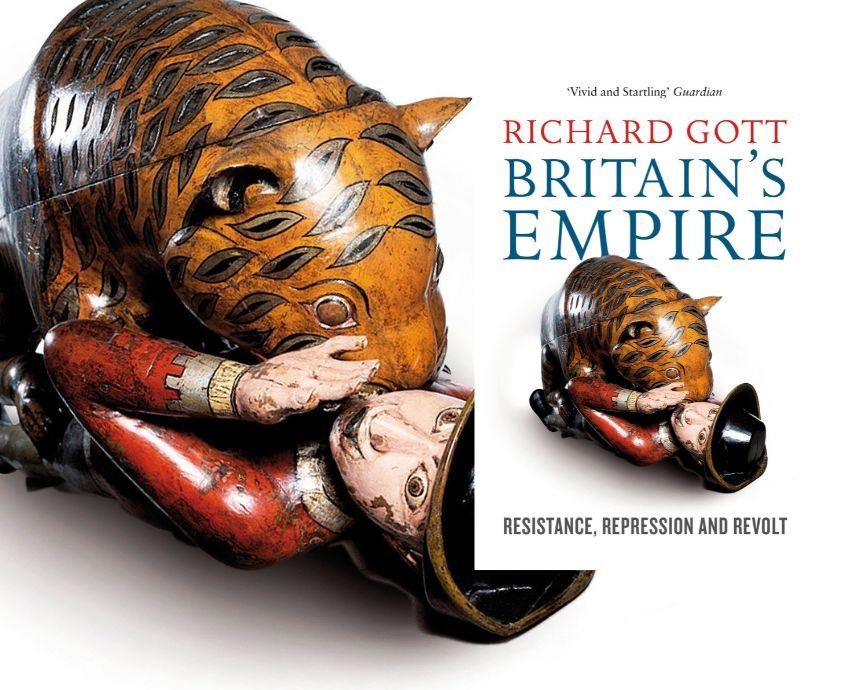
Britain’s Empire: Resistance, Repression and Revolt
By Richard Gott
London, Verso Books, 2011
478pp
Tipu’s Tiger is a mechanical toy that depicts a tiger mauling a British soldier, created in the 1790s for the Tipu Sultan, who became ruler of the Indian Kingdom of Mysore in 1782. Tipu fought against the forces of the British East India Company from the 1760s until his death in the aftermath of the Siege of Seringapatam in 1799.
It is appropriate, therefore, that Tipu’s Tiger, a symbol of resistance to British rule graces the front cover of Guardian journalist and author Richard Gott’s Britain’s Empire: Resistance, Repression and Revolt.
Gott also wrote Cuba: A New History (2004) and Hugo Chavez: The Bolivarian Revolution in Venezuela (2005). Britain’s Empire covers more than a century of resistance to British colonial expansion, from the French and Indian wars of 1755‒63 through to the Great Indian Mutiny of 1857‒58.
Colonial powers including Britain have always claimed that they are a driving force for civilisation and progress. However, in reality, violence and repression have always reinforced colonial rule — a fact often overlooked by mainstream historians from the Victorian era to today.
Britain’s Empire places the revolutionaries and rebels who stood up to the British empire and the bloody repression that the British authorities used to crush resistance at its centre. It spans the globe, from Ireland, North America, South Africa, India, Australia to New Zealand.
Resistance to British colonialism in Ireland had existed since the Anglo-Norman invasion and Gott examines the creation of Catholic peasant secret societies such as the Whiteboys as acts of resistance against the Anglo-Protestant landlord class that dominated. It was in response to these societies that the Loyalist protestant Orange Order was created in 1795.
Inspired by the French Revolution, the Irish Republican United Society of Irishman was formed in 1791 and in 1798 staged a rebellion against British rule. Further unsuccessful revolts were staged in 1803 and 1848. Irish resistance often continued in Britain’s colonies, such as at the Vinegar Hill rebellion in Sydney in 1804.
Tragically, the Irish, along with Scottish peasant farmers driven off their land due to the highland clearances, convicts and political prisoners sent to Britain’s far-off gulags, as well as soldiers, sailors and settlers press-ganged from the ranks of the unemployed became the oppressors in Britain’s colonies.
In the Americas, Australia, New Zealand, South Africa, Canada, Rhodesia and Kenya, white settlers simply took over land that was not theirs, often slaughtering, and even purposefully exterminating, the local Indigenous populations when they resisted British colonial expansion.
Ironically these groups were often as much as a thorn in the side of British rulers as Indigenous resistance. For example, in the American War of Independence (1775‒83), revolts such as the 1808 New South Wales Rum Rebellion and the 1854 Eureka stockade in Colonial Australia, the Boer resistance in South Africa from the 1830s onwards and the French Canadian revolt of 1837‒38.
Between 1755 and 1858, British imperial expansion continued to be resisted. Gott puts the men and woman of the Pontiac in North America, Tacky and Nanny in Jamaica, Papineau in Quebec, Wickrama Sinha in Ceylon, Myat Toon in Burma and Lakshmi Bai in India at the center their communities in resistance.
While this resistance was often bloodily crushed, British Imperialism suffered a number of defeats such as in the American War of Independence. The Haitian slave rebellion forced British soldiers to withdraw in 1798 and the Javanese resistance in the 1810s thwarted Stamford Raffles’ dreams of the East India Company’s expansion in South-East Asia.
Moreover, as with the many white settler revolts, failed Indigenous and slave revolts forced concessions from the British. In the aftermath of the great slave revolt in Jamaica (1831‒32), despite the revolt being crushed, it accelerated Britain’s abolition of slavery in 1833.
Gott’s century-long narrative culminates with the Great Indian Mutiny of 1857‒58 in which a mutiny in May 1857 of Indian Sepoy’s employed by the British East India Company spread to a nationwide revolt, uniting Hindu and Muslim soldiers. It was only defeated by the East India Company, with much brutality and bloodshed, in September 1858.
After the defeat of the revolt, the control of India was taken from the East India Company by the British Crown. While Britain’s Empire ends at this point, the cycle of resistance, repression and revolt continued well into the 20th Century with the partition of many of its former colonies in Ireland, India and Palestine and the bloody suppression of revolts such as the Mau Mau in Kenya in the 1950s.
Even after India gained its Independence in 1947, with the rest of its colonies gaining independence in the 1950s and ‘60s, British imperialism continued to play a key role as junior partner to the United States. Most British historians and commentators continue to sanitise it.
Tipu’s Tiger is one of the many treasures that Britain plundered from its colonies. Many of these former colonies have demanded their treasures be returned.
Originally written in 2011, Britain’s Empire is still relevant. It shows the Empire’s brutal reality and put at the centre those resisting its expansion, providing an inspiration in the continued fight for a better world.